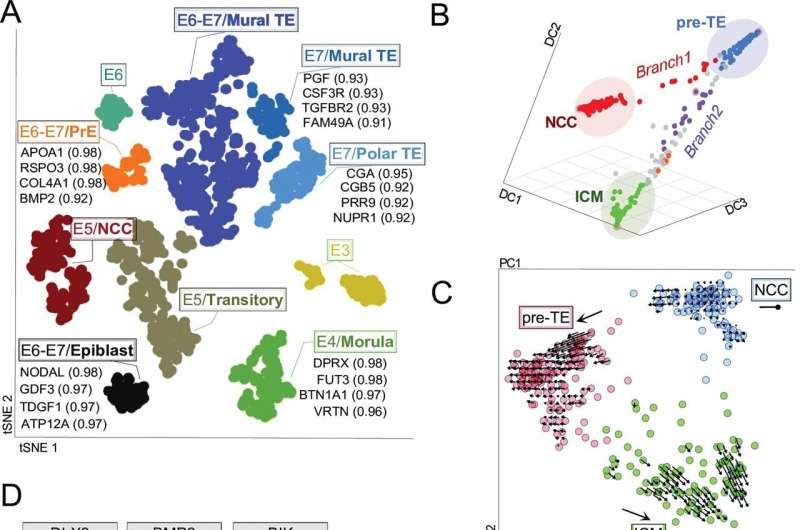This article has been reviewed according to Science X's editorial process and policies. Editors have highlighted the following attributes while ensuring the content's credibility:
fact-checked
peer-reviewed publication
trusted source
proofread
Scientists discover new embryonic cell type that self-destructs to protect the developing embryo

Scientists studying gene activity data of the early human embryo have discovered an overlooked type of cell that self-destructs within days of forming, as part of a quality control process to protect the developing fetus. The findings give insights on what happens at the very first stages of life after fertilization which could in the future help improve IVF or regenerative medicine treatments.
A new study published on 20 June 2023 in PLoS Biology by an international team of scientists including researchers at the University of Bath, finds that our earliest development in the womb may be rather different to what we have always assumed.
While human adults are made up of trillions of cells, we all started out as just one cell, the fertilized egg. This divides to become two cells which in turn divide to become four, which become eight and so on. At some point the cells then start to specialize in their function. Like trains sent to different end stations, some will be shunted off to become the placenta while others will become the embryo.
Self-destructing embryonic cell
The team of scientists analyzed previously published data on gene activity of each individual cell from 5-day old embryos and discovered around a quarter of the cells didn't fit the profile of any of the known cell types (pre-embryo, pre-placenta etc.).
Investigating further, they discovered that these cells contained so-called "Young transposable elements" or "jumping genes." These are rogue elements of DNA that can copy themselves and insert themselves back into our DNA, often causing damage in the process.
Staining of embryos by project collaborators in Spain confirmed the existence of the cells with proteins derived from the jumping genes.
Looking a little further forward in time, the team found their descendants both have DNA damage and undergo a process of programmed cell death.
Quality control mechanism
This process, the researchers suggest, looks like a form of quality control: selection between cells in favor of the good ones.
Dr. Zsuzsanna Izsvák, co-senior author from the Max Delbrück Center and an expert on mobile DNA, said, "Humans, like all organisms, fight a never-ending game of cat and mouse with these harmful jumping genes.
"While we try and suppress these jumping genes by any means possible, very early in development they are active in some cells, probably because we cannot get our genetic defenses in place fast enough."
Co-lead author Professor Laurence Hurst, from the Milner Centre for Evolution at the University of Bath, said, "If a cell is damaged by the jumping genes—or any other sort of error such as having too few or too many chromosomes—then the embryo is better off removing these cells and not allowing them to become part of the developing baby.
"We are used to the idea of natural selection favoring one organism over another. What we are seeing within embryos also looks like survival of the fittest but this time between almost identical cells. It looks like we've uncovered a novel part of our arsenal against these harmful genetic components."
Using old genetic enemies to fight new ones
Conversely, the single-cell data showed that the key cells that will become the embryo (the inner cell mass or ICM) don't contain jumping genes but instead express a virus-like gene called human endogenous virus H. This helps suppress the young jumping genes in the inner cell mass, fitting with an emerging pattern that we use our old genetic enemies to fight our new ones.
The authors suggest that if the quality control process is too sensitive, the embryo as a whole may die. This might explain why some mutations in our system to detect damage in early embryos are also associated with infertility.
More information: Manvendra Singh et al, A new human embryonic cell type associated with activity of young transposable elements allows definition of the inner cell mass, PLOS Biology (2023). DOI: 10.1371/journal.pbio.3002162
Journal information: PLoS Biology
Provided by University of Bath





















